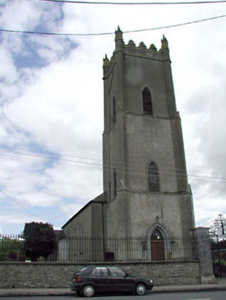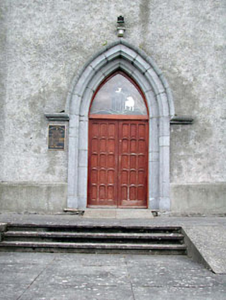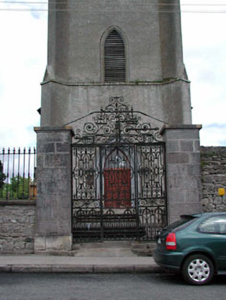Survey Data
Reg No
11816024
Rating
Regional
Categories of Special Interest
Architectural, Artistic, Scientific, Social
Previous Name
Saint John's Church (Monasterevin)
Original Use
Church/chapel
In Use As
Church/chapel
Date
1765 - 1775
Coordinates
262723, 210229
Date Recorded
28/05/2002
Date Updated
--/--/--
Description
Detached four-bay double-height Gothic-style Church of Ireland church, built 1769-72, with single-bay single-storey vestry projection to north-west and single-bay three-stage entrance tower to south-west on a square plan with battlemented parapet. Gable-ended roofs with slate. Red clay ridge tiles. Rendered coping to gables. Cast-iron rainwater goods on eaves course. Roof to tower not visible behind parapet wall. Lime rendered walls. Unpainted. Rendered dressings including surrounds to gables to nave forming 'pediments'. Diagonal stepped buttresses to tower with triangular motifs. Rendered string/sill courses to each stage. Battlemented parapet wall to tower on stringcourse with corner pinnacles. Lancet-arch window openings. Cut-limestone chamfered sills and reveals with hood mouldings over. Fixed-pane windows to nave. Lancet-arch openings to upper stages to tower. Rendered sill course to each stage. Rendered surrounds. Louvered timber panels. Pointed-arch door opening approached by flight of three stone steps. Moulded cut-stone surround with hood moulding over. Replacement timber panelled door, c.1980. Overlight. Set back from road in own grounds. Graveyard to site with various cut-stone grave markers, c.1820-c.1920. Gateway to south-east comprising pair of cut-limestone piers with decorative wrought iron double gates having decorative overpanel and rubble stone flanking boundary wall with iron railings over.
Appraisal
The design of the original church has been attributed to the architect Christopher Myers by Dr. F O’Dwyer. He was probably commissioned by Charles, 6th Earl of Drogheda. A brass plate, on one of the pews, records its opening in 1772, although 1820 is indicated on the gallery, perhaps reflecting ongoing works on the building. Stained glass window (1918) by A.E. Child. It is of social interest as the ecclesiastical centre for the Church of Ireland community in the locality. The church is without superfluous ornamentation and employs little detailing with the exception of diagonal buttresses and rendered stringcourses to the tower, both of which are given a structural role in the design (the buttresses appear to support the tower, while the stringcourses double as continuous sill courses), together with simple surrounds to the openings. The building relies on the regular displacement of slender lancet-arch openings for visual variety, with the emphasis of the composition placed on the soaring tower to south-west that serves to identify the church in the surrounding landscape, the battlemented parapet with pinnacles articulating the skyline. The church retains most of its original form and character, with early features and materials in situ, including fittings to the window openings, and slate roofs having cast-iron rainwater goods. It is possible that the interior also retains early or original features and fittings of significance. Set back slightly from the line of the road, the church adds variety to the streetscape of Main Street, interrupting the established streetline of the flanking terraces. It is surrounded by an attendant graveyard, the markers of which are of some artistic interest. Also of artistic interest is the intricate gateway to south-west, a good example of early decorative iron work.





